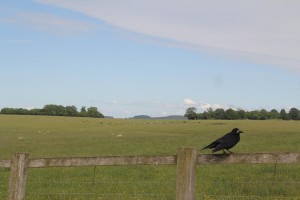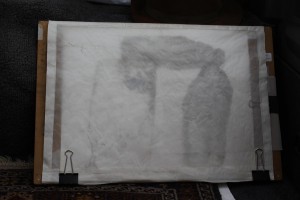Stonehenge – Friday 14th June
The signs are out along the roads leading to Stonehenge warning of delays on the 20th June from 6pm. The special solstice car park – in other words, an extremely large field – opens at 7pm. If this year’s solstice is anything like last year’s, the queue of cars waiting to go in will stretch an extremely long way away from Stonehenge. But it’s all part of the summer solstice experience.
Along the Stonehenge byway a collection of campervans and converted trucks are already gathering. The fever has begun.
It’s a bright, windy, cloudy day and the trees in the car park are thronging with birds. The crows and starlings all have fledglings in tow; the sheep in the adjacent field are escorting chubby youngsters through the long grasses and meadow flowers. It’s all positively picturesque, apart from the cars and coaches and waves of tourists.
I notice a motorbike, a trail-bike in the field with the sheep. It’s the farmer looking super cool in dark aviator sunglasses, his sheep dog riding up front between his legs and across the petrol tank. He’s gently meandering around his flock, checking up that they’re all alright.
Over by the Stonehenge entrance, lines of visitors queue politely to be counted in to the ancient monument.
Mark goes up to the Stones to continue his silverpoint drawing. It’s very hard won this image.
I’m lingering in the truck for a while, watching the Stonehenge experience from here.
There’s a constant stream of people in and out of the meadow.
An Indian woman in unsuitable footwear picks her way across the long grass, holding her smart phone up towards the sheep. Seeing her, another couple of women venture into the field, similarly chasing the sheep with their smart phones. The sheep look up and move away. They make very reluctant celebrities.
I’ve watched this strange over enthusiastic behaviour towards sheep – or the photo opportunity with sheep – throughout the year as people rush to photograph the flock in the meadow up by the Stones, so this shouldn’t really surprise me. I just don’t really know what’s going through people’s heads. If they run towards the sheep, the sheep run off. This seems, to me, to be an indication that sheep don’t like people running at them, but no. Some people keep chasing them…as though what? They’re going to run those sheep into the ground until they submit – damn it! – and pose nicely for a photo?
Two National Trust 4x4s drive through the field, one towing a trailer containing rolls of wire. It’s a large landscape to manage around here, but they’re very fastidious about their duty of care. The work on fences and gates, hedges and woodlands, pastures and access ways, is constant.
A couple spread a picnic blanket out on the grass and lie down for a siesta.
The starlings swoop in and drift among the sheep. If the constant noise of traffic could somehow be eliminated, it would be quite peaceful here. But I expect that for a lot of visitors, travelled here from the metropolitan centres, it’s that sense of an expansive space that’s the headiest sensation.
And this does seem to be the case with so many ancient sites. Whatever they were when in use for the purpose for which they were originally designed, subsequent generations didn’t make them the centres of their societies. Towns and cities were established in other places, and the open, rolling landscape of the South-west of England is littered with remote ancient hill forts, barrows, burial mounds and Neolithic remains, long abandoned by all but the local farming community. And Stonehenge appears exactly like this – apart from the carefully managed colossal movable population arriving in daylight hours and disappearing every evening.

